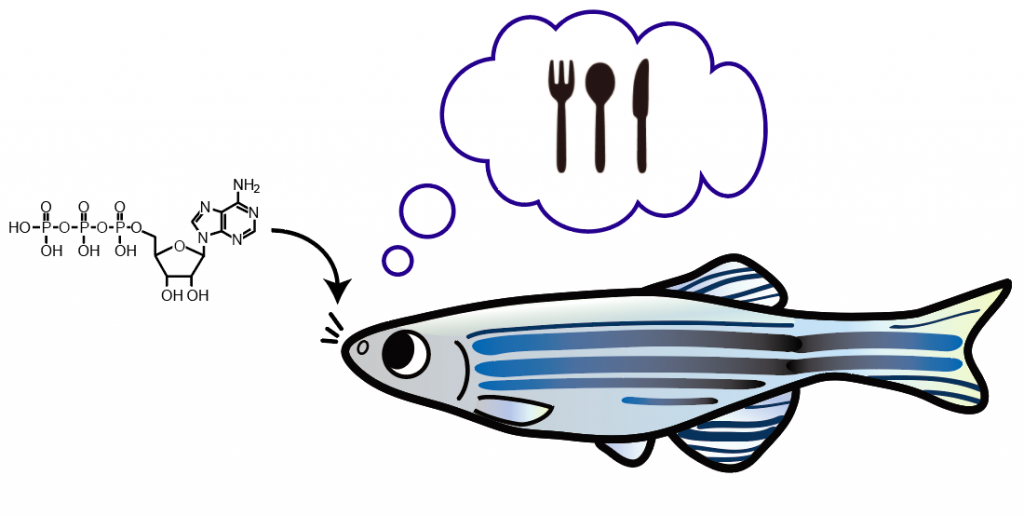Fish love the smell of adenosine — well, anytime
Olfactory receptor that senses food signals is unique to aquatic species
May 12, 2017
Amanda Alvarez
This post originally appeared on Neurographic

The appetizing scent of ATP. Image: Yoshihara lab/RIKEN Brain Science Institute
When we last caught up with Yoshihiro Yoshihara, his lab had just revealed that the sense of smell is crucial for fish to detect a pheromone that triggers spawning behavior. Being able to sense prostaglandin F2α is literally a ticket to reproduction for zebrafish, according to the study published last year. Now, the lab has dissected how fish process another smell crucial for survival: that of ATP, or adenosine triphosphate. This molecule may be familiar from high school biology as a unit of energy within cells, but it’s also a by-product of grinding up brine shrimp for fish food (yum!). Fish are super-sensitive to ATP, which indicates that a food source is fresh, because only live prey give off ATP. Here’s a video showing how zebrafish are drawn to ATP in the water.
Yoshihara and colleagues at the RIKEN Brain Science Institute have now mapped out how ATP is smelled by fish, triggering the excited food-seeking behaviors seen above. They identified a completely new receptor, called A2c, in the zebrafish nose. What’s more, this receptor was only found in some odd olfactory sensory neurons: these ‘pear-shaped’ neurons express only the A2C receptor, not conventional olfactory receptors, and are quite distinct from the four other types of primary sensory neurons in the fish nose.
It’s not entirely straightforward for ATP or other waterborne chemicals to get into the nose, however. To counter stagnant water and blocking mucus, Yoshihara thinks beating nose hairs may aid fluid flow into the fish nostril. After that, a two-step enzymatic reaction is needed to break ATP down into its constituents, facilitating the binding of adenosine to the receptor, which does not recognize ATP itself. Once this happens, though, the food signal has a fairly privileged path into the brain, activating a single large glomerulus, or concentrated bundle of neurons, within the brain area responsible for smell called the olfactory bulb. The end result is foraging behavior brought about by the four higher brain areas following the olfactory bulb that control motor and perceptual functions.

The olfactory epithelium in the zebrafish nose, showing cells (in blue) that have been stimulated with ATP. In red are the ‘pear-shaped’ olfactory sensory neurons expressing c-Fos, a marker of neural activity. In green are ciliated olfactory sensory neurons expressing a conventional odorant receptor. Image: Yoshihara lab/RIKEN Brain Science Institute
The A2c adenosine receptor may be a bit of an evolutionary throwback. The gene that encodes it, A2c, doesn’t exist in terrestrial vertebrates — that is, birds, reptiles, or mammals — only in fish and amphibians. The gene may have been lost when vertebrates climbed out of the seas onto land millions of years ago, says Yoshihara, when it was no longer necessary to smell ATP in water. Highly similar genes like A2a and A2b are, however, present in terrestrial species, with similar biochemical outcomes — receptors that pick up adenosine inside the body and use this chemical signal for communication between cells. Whether on dry land or underwater, all species use adenosine, after all!
Wakisaka N, Miyasaka N, Koide T, Masuda M, Hiraki-Kajiyama T, Yoshihara Y (2017). An adenosine receptor for olfaction in fish. Current Biology, DOI: 10.1016/j.cub.2017.04.014